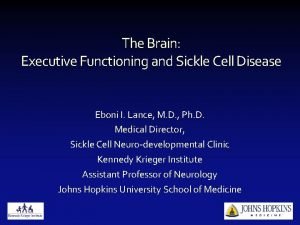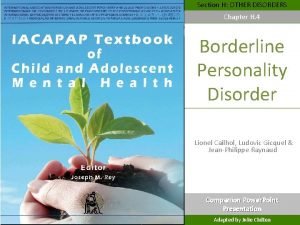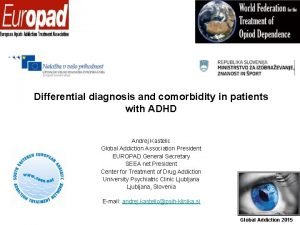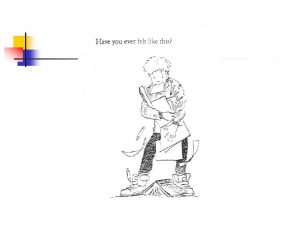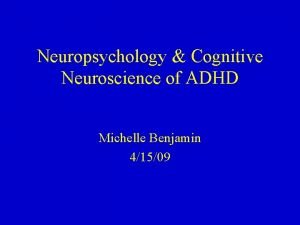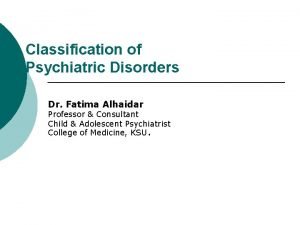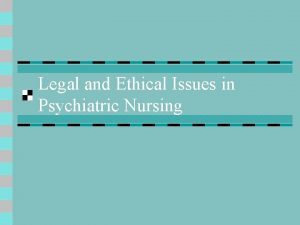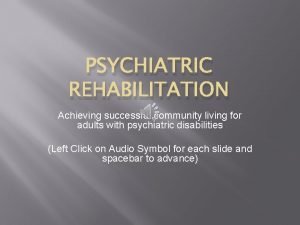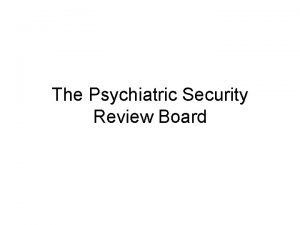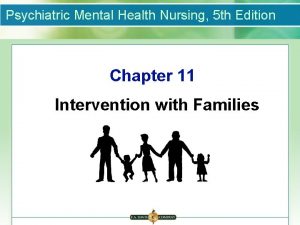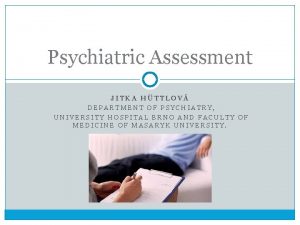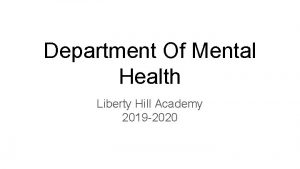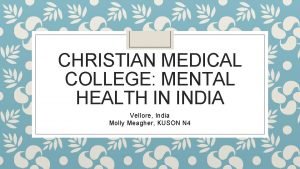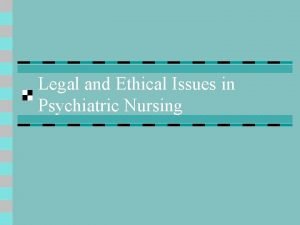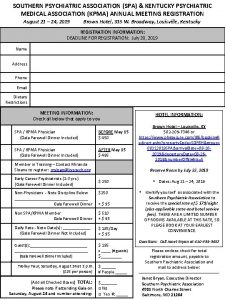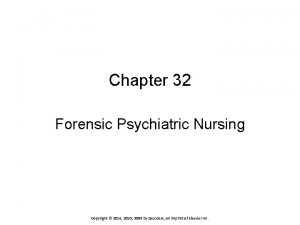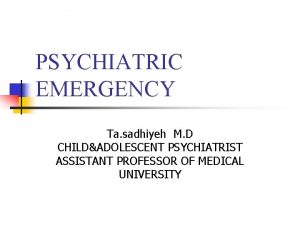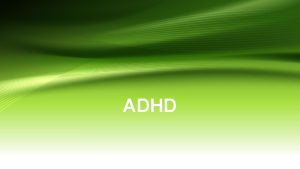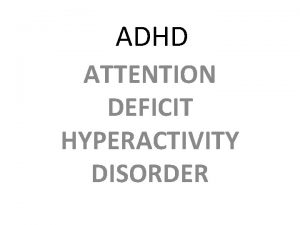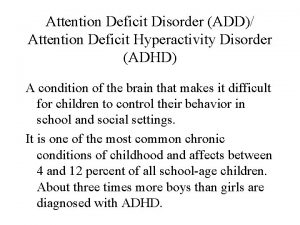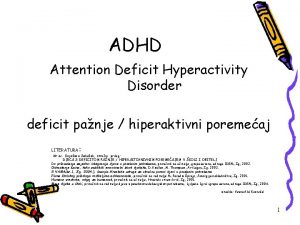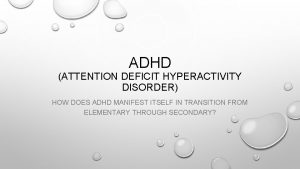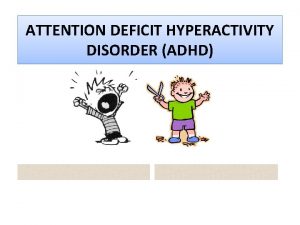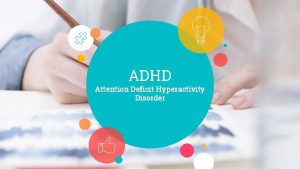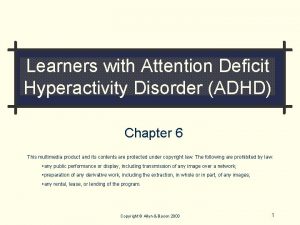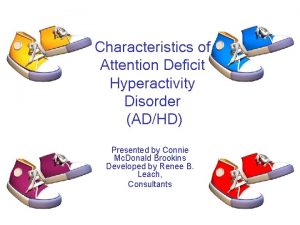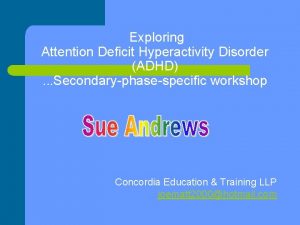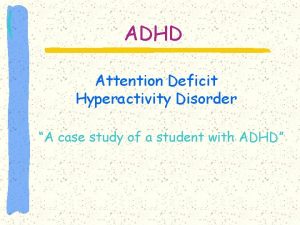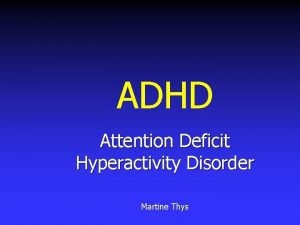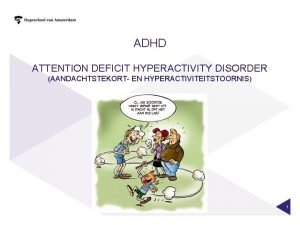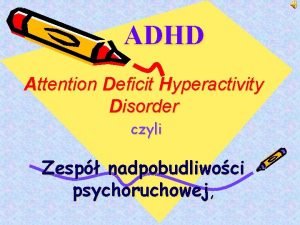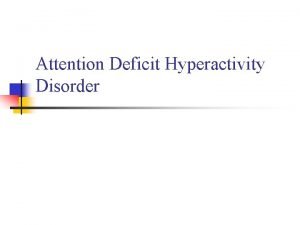ADHD ADHD Attention Deficit Hyperactivity Disorder Psychiatric disorder




















- Slides: 20

ADHD

ADHD • Attention Deficit Hyperactivity Disorder • Psychiatric disorder of the neurodevelopmental type in which there are significant problems of • Attention • Hyperactivity • Acting impulsively • Affecting 6 -10 % of school aged children • Symptoms must begin by age six to twelve and persist for more than six months for a diagnosis to be made • Cause: of most cases is unknown, but it is believed to involve interactions between genetic and environmental factors. Certain cases are related to previous infection of or trauma to the brain.

Signs and Symptoms of ADHD • Inattention, hyperactivity, disruptive behavior, and impulsivity are common in ADHD • The symptoms can be difficult to define as it is hard to draw a line at where normal levels of inattention, hyperactivity, and impulsivity end and significant levels requiring interventions begin • Diagnosis is made up per the fifth edition of the Diagnostic and Statistical Manual of Mental Disorders (DSM-V), Symptoms must be observed in multiple settings for six months or more and to a degree that is much greater than others of the same age • Based on the symptoms, ADHD can be divided into three subtypes • Predominantly inattentive • Predominantly hyperactive-impulsive • Combined

Ethiology • Neurochemical, structural and functional brain differences in ADHD. -“Therefore, ADHD can be better conceptualized as a multisystem developmental disorder with a variety of clinical expressions (Dahan et al. 2018) =) so, it actually means: there are many of different symptomswhich cannot be succesfully bordered and explane, so we call them together ADHD : )). • motor + cognitive + emotional sphere • Pathways dysfunctions • Mesolimbic -> reward-related cognition • Mesocortical -> executive functions • Nigrostriatal -> motor function and movement coordination

Pathways

Symptoms of ADHD Predominantly inattentive • Be easily distracted, miss detail, forget things, and frequently switch from one activity to another • Have difficulty maintaining focus on one task • Become bored with a task after only a few minutes, unless doing something enjoyable • Have difficulty focusing attention on organizing and completing a task or learn something new • Not seem to listen when spoken to • Daydream, become easily confused, and move slowly • Have difficulty processing information as quickly and accurately as others

Symptoms of ADHD Predominantly hyperactive-impulsive • Talk nonstop • Dash around, touching or playing with anything and everything in sight • Have trouble sitting still • Be constanly in motion • Have difficulty doing quiet tasks or activities • Be very impatient • Have difficulty waiting for things they want • Difficulties processing verbal and nonverbal language • Delays in speech, language and motor development

Gender differences in ADHD • Girls with ADHD aren´t usually hyperactive. Instead they tend to have the attention-deficit part of the disorder • The stereotype of someone with ADHD is a hyperactive boy • ADHD also affects girls and even adult women • Parents, teachers and others often overlook ADHD in girls, because their symptoms differ from those of boys

• Although ADHD causes significant impairment, particularly in modern society, many children with ADHD have good attention span for tasks they find interesting. • It may also lead to the mistake that they can be percieve as the Autism Spectrum Disorder (ASD).

ADHD Gross-motor Development • Difficulty with bodily coordination is often times a characteristic in ADHD. • Children with ADHD might struggle with grossmotor skills as a result of their inability to slow down and focus on their movements; walking, kicking a ball and playing sports.

Research results • According study done in Australia (2003) about gross and fine motor abilities in males with ADHD, they found that the children with ADHD had significant poorer movement ability than control children. • A high percentage of these children displayed movement difficulties consistent with developmental coordination disorder (DCD) • Study also found that the type and degree of movement difficulty differed between subtypes • Less severe for subtype hyperactive/impulsive than the two others • Males with subtype predominantly inattentive and combined had significantly poorer fine motor ability than control males.

Research results • The ADHD hyperactive/impulsive group did not differ significantly from any of the others groups. • As children with ADHD only and the control group did not differ significantly on fine motor ability, but were better than children categorized with both ADHD and DCD, it was argued that poorer fine motor ability found in children with ADHD could not be attributed to deficits in attention and concentration, but rather to factors relating to their motor ability. • A further aim of the study was to determine the impact of having both ADHD and DCD, in contrast with ADHD only.

ADHD Fine-motor development • Fine-motor skills are inherent in activities conducted with the hands and wrists such as writing, drawing and tying shoes • Children with ADHD often have trouble with writing • Writing problems - two main areas: • • Composition (putting thoughts into words and putting those in order) • Transcription (putting the words on paper) Children with ADHD may need help for both aspects

• Transcription problems may include: • difficulty writing smoothly and easily • slow and strenuous and/or fast careless approach • poor written spelling • messy, uneven handwriting • letters are reversed, rotated and generally unrecognizable

• Composition problems may include: • Poor written sentence construction • Poor use of punctuation and grammar • Poor story composition, including lack of organization, missing story elements and details, missing reasons, or missing conclusions

Management/Treatment • Typically involves counseling/psychotherapy or medications either alone or in a combination. While treatment may improve long-term outcomes it does not get rid of negative outcomes entirely • Medications used includes stimulants, atomoxetine, alpha-2 adrenergic receptors agonists - they have at least some effect in about 80 % of people • Dietary modifications may also be of benefit with evidence supporting free fatty acids and reduced exposure to food coloring

Educational methods Academic instructions - Introducing lessons - Conducting lessons - Concluding lessons It is important to give clear explanations and constant feedback about there work. Behavioral interventions Classroom accomodations - Be consistent and clear - Childs sit near the teacher - Verbal reinforcement or a model student - Praise children for all - Use of pointers, egg good action, encouraging timers, classroom lights, them to follow music… - Provide low-distraction work areas

Suitable educational approach • Classroom assistance • Advisory teachers: educate the school teachers about handling this condition • Communicating feedback • Reward good behavior • Access to psychologue • Implement more breaks • Avoid to overload the students • Encourage support

Other approach • Constistent and positive oriented parent approach • Proper nutrition • Danger of energy drinks

Thank you for your attention!
 Autism spectrum disorder adhd
Autism spectrum disorder adhd Adhd and borderline personality disorder
Adhd and borderline personality disorder Adhd or bpd
Adhd or bpd Is adhd a neurological disorder
Is adhd a neurological disorder Alternating attention vs divided attention
Alternating attention vs divided attention Dsm 5 munchausen by proxy
Dsm 5 munchausen by proxy Psychiatric disorders
Psychiatric disorders Legal issues in psychiatric nursing
Legal issues in psychiatric nursing Psychiatric rehabilitation
Psychiatric rehabilitation Psychiatric security review board
Psychiatric security review board Calgary family assessment model
Calgary family assessment model Mse psychiatry
Mse psychiatry Liberty hill academy
Liberty hill academy Cmc psychiatric hospital
Cmc psychiatric hospital Nursing process in psychiatric nursing
Nursing process in psychiatric nursing Psychiatric nurse conference
Psychiatric nurse conference Pes in nursing process
Pes in nursing process Defense mechanisms nursing
Defense mechanisms nursing Southern psychiatric association
Southern psychiatric association Role of psychiatric nurse
Role of psychiatric nurse Psychiatric emergency
Psychiatric emergency
